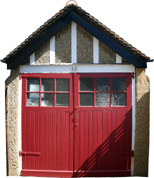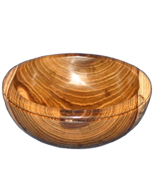
PHASE 6. Installation of wall insulation & OSB
sheathing.
(This page)

PHASE 6. Installation of wall insulation & OSB
sheathing.
(This page)

Synopsis of Work for Installing Wall Insulation
& OSB Wall Sheathing.
Work on all aspects was carried out in parallel.
Why Insulate?
If the intention is to spend considerable time in the
workshop during the winter months and be reasonably
comfortable and warm, then insulation of walls &
ceiling is, in my view, essential. With insulation in
place, I have found that using a small oil-filled
electric radiator, it is easy to maintain a working
temperature in excess of 20o C. Conversely, in the heat of the summer, the workshop keeps comfortably cool at a temperature of 18o C.
Details
I decided to use Celotex foil faced insulation
board, 40mm thick for the stud walls (to fit between
the 45mm thick stud timbers), and 50mm thick for the
partition wall (to fit between the 70mm thick stud
timbers). However, I found that obtaining board of
the desired thicknesses was not easy! B &
Q and Wickes both stock Celotex but
not of the thicknesses that I required, and they will
not order the desired thicknesses either which I
think is very poor service!
I then tried ordering online from Travis Perkins where the desired thicknesses were listed as being available on their website. However, I then received a phone call to say that that although listed as available, the boards of the required thicknesses were not stocked, and likewise unavailable.
Eventually I found a company called Insulation Giant where the required boards were listed on their website, confirmed as available and delivered after a few days at a reasonable price. Can recommend them.
After cutting & fitting the insulation boards between the studs, foil insulation tape was used for sealing the joints between the studs and foil-faced insulation boards. This prevents air leakage, completes the vapour control layer and maximises thermal performance. A polythene vapour barrier was stapled to the studs before the OSB boards were screwed in position on top.
Installing a Vapour Control Layer.
This is used to prevent the passage of water or
moisture from within the workshop to the timber
frame. People and their associated activities within
the workshop will produce water vapour which, if
unmanaged, can condense within or between building
elements; a process referred to as interstitial
condensation. This condensation can have serious
detrimental effects upon the building fabric, such as
causing the decay of the timber framework and
corrosion of the metal fastenings, and it may also
reduce the thermal effectiveness of the insulating
materials. A Vapour Control Layer provides a means of
protecting the warm side of the thermal insulation
incorporated in a building by creating a barrier to
the movement of warm, moist air.
Oriented Strand Board (OSB), also known as Sterling Board, Sterling OSB, Aspenite, and Smartply in British English, is an engineered wood particle board formed by adding adhesives and then compressing layers of wood strands (flakes) in specific orientations. OSB may have a rough and variegated surface with the individual strips of around 25mm × 150mm (1" × 6"), lying unevenly across each other and comes in a variety of types and thicknesses.
Reasons for Use.
OSB is a mechanically strong sheathing which has a
uniform consistency. It is a very effective substrate
for the attachment of a variety of fittings such as
shelves, electrical conduit and associated metal-clad
sockets. The 18mm thickness OSB was preferred for
mechanical strength and for accepting fixtures. OSB3
is a precision-engineered structural board for use in
load-bearing humid conditions and is specifically
recommended for wall sheathing, hence its use in this
project. OSB is a much cheaper option than using
plywood and is more consistent in properties with,
for example, no hidden voids as is commonly the case
with plywood.
Fixing to Studwork.
Fixings should generally be long enough to allow
about 20mm penetration into the substrate or have an
overall length of about 2.5 times the panel
thickness, whichever is the greater. Parallel core
screws should be used because they have greater
holding power than conventional tapered wood screws.
Drill pilot holes for all screw fixing. Typically,
the holes should be 85 to 90% of the screw core
diameter. Fixings into the board face should not be
within 8mm of edges and 25 mm of the corners. In
environments with typical humidity and temperature
conditions, it is recommended that when fixing
adjoining square edged panels, that a 3mm gap should
be left at all edges of each panel. Nailing the
boards to the studwork is also an option, but in this
instance screwing was the preferred option.
Details of Installation.
13th August 2015..
11 Sheets of OSB (for wall sheathing), and 2 sheets
of insulation board (for partition wall), and some
replacement roof ties delivered. All from Travis
Perkins
Click HERE to return to the Home Page.
© Tim & Trish Enterprises 2015-2017.